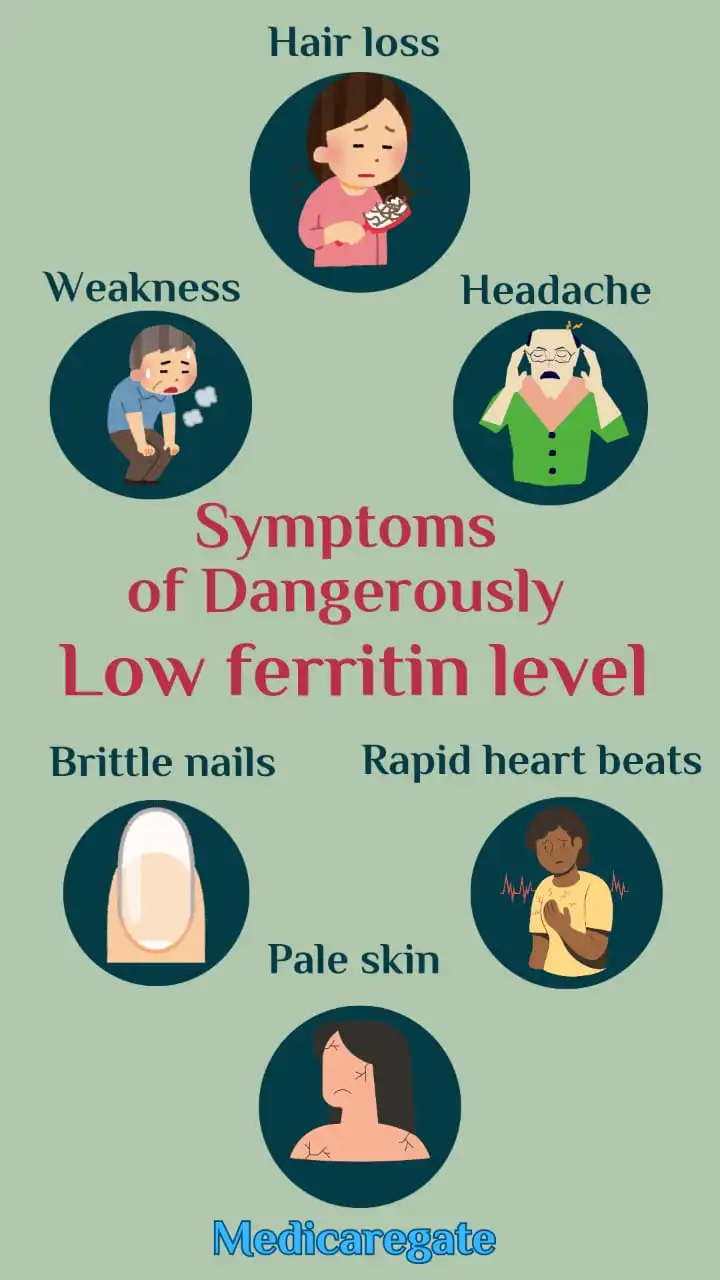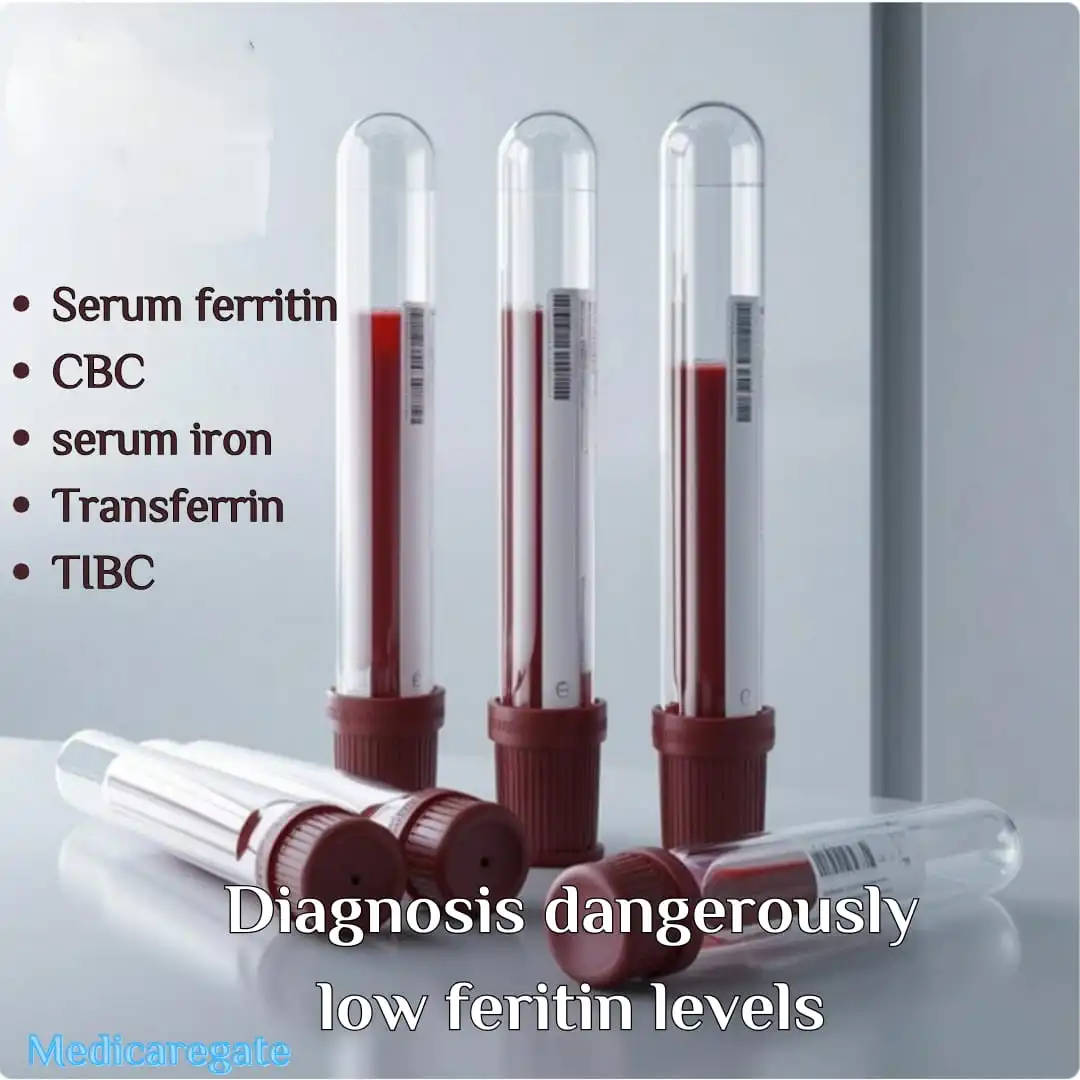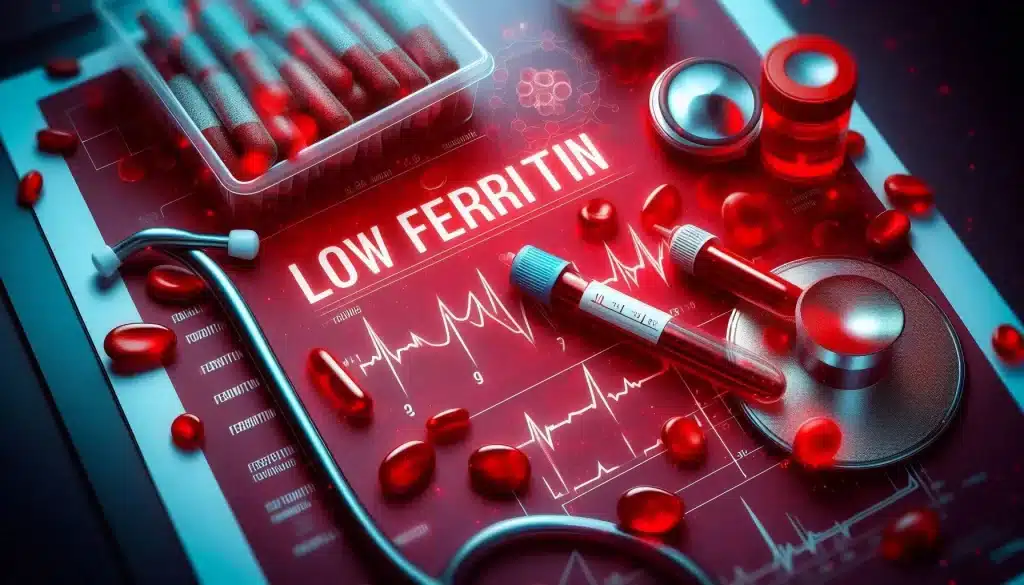Introduction
Ferritin is a of protein produced throughout mammalian metabolism that stores iron in the tissues. In this article, we will explain the causes of dangerously low ferritin levels, symptoms, and the best ways to treat and prevent these problems.
Healthy red blood cells and other organs, such as the liver, bone marrow, and muscles need iron and any disturbance in its levels can lead to serious health issues.
What Are Dangerously Low Ferritin Levels?
The World Health Organization classifies dangerously low ferritin levels as those less than 15 μg/L for adults and 12 μg/L for children.
The ferritin levels can be one of the following ranges: –
- Low < 15 μg/L.
- Borderlines 16 – 40 μg/L.
- Normal 41- 400 μg/L.
- High> 400 μg/L.
Accordingly, a low ferritin level is a biomarker for diagnosing iron deficiency (ID).
In 2002, the WHO classified ID as one of the top ten factors that contribute to risk for disease worldwide.
Iron deficiency is the term used to describe a situation in which the body’s iron stores are insufficient to meet its needs.
Causes of Dangerously Low Ferritin Levels
Ferritin is responsible for iron absorption, storage, and release.
It remains in bodily tissue until it is required for erythropoiesis (the production process of red blood cells in bone marrow).
As a result, the body releases iron when it needs it and attaches it to transferrin, a protein found in plasma.
Transferrin delivers iron to erythropoietic cells (precursor cells that form red blood cells in bone marrow) and to other organs such as the liver and spleen.
A low ferritin level correlates directly with the quantity of iron stored in the body.
Several factors contribute to that, such as: –
- Decreased iron dietary intake.
- Blood Loss.
- Decreased iron absorption.
1. Decreased Iron Dietary Intake
Your body stores iron but can’t produce it; for this reason, you must intake a diet containing iron. Here is a complete list of iron-rich foods.
Thus, people are at risk for being exposed to iron deficiency and need iron in their diets more than others, for example: –
- Children and teenagers.
- Females during the menstrual cycle → As they suffer from menorrhagia, where some evidence suggests that about 31- 44% of cases of ID in women of reproductive age.
- Pregnant women → They need extra iron due to increased maternal RBC production. Whereas, ID raises the risk of preterm birth, low birth weight, and mother and infant death.
- Breastfeeding → A long time affects the mother and her baby.
- Vegetarian people → Due to their specific restricted diets that have low iron content.
- Blood donors → They have a risk of ID, according to studies in the USA that indicate about 25%-35% of regular blood donation suffer from low ferritin levels and ID.
2. Blood Loss
Many reasons can cause blood loss which has negative effects on serum ferritin and iron levels, such as: –
- Peptic ulcer disease.
- Gastritis.
- Esophageal varices.
- Heavy menstrual bleeding.
- Bleeding disorders.
- Schistosomiasis.
- Hemodialysis.
- Anticoagulant medications like aspirin and NSAIDs.
3. Decreased Iron Absorption
The small intestine is the site of absorption of digested nutrients, including iron.
Some conditions can cause malabsorption of iron that affects ferritin levels, such as: –
- Chronic pancreatitis.
- Cystic fibrosis.
- Obstructive jaundice.
- Celiac disease.
- Inflammatory bowel disease.
- H. Pylori infection.
What Causes Low Ferritin With Normal Hemoglobin
This case is called iron deficiency without anemia (IDWA).
Patients usually suffer from unexplained symptoms with low ferritin levels and normal Hb concentration which occurs due to some causes such as: –
- Low dietary intake of iron.
- Malabsorption of iron.
- Chronic inflammation as celiac disease and IBD.
- Chronic occult blood loss is common in women with menorrhagia.
- Obesity.
- Rapid growth in adolescents.
Symptoms of Dangerously Low Ferritin Levels
When the ferritin level drops severely below normal, it causes ID as previously demonstrated, which implies fewer red blood cells (RBCs) that deliver oxygen to the organs.
Here are some common symptoms of iron deficiency demonstrated in the following table: –
- Excessive tiredness and dizziness over a long period of time.
- Breathing difficulties.
- Irregular and fast heartbeat.
- Chest pain especially during activity.
- Weakness.
- Vertigo.
- Painful headaches.
- Changes in mood.
- Yellow-coloured skin.
- Swelling of tongue.
- Loss of hair.
- Brittle nails.
- Restless legs.
- Sleep disturbance.

Low Ferritin Symptoms in Females
Menstruation is the primary cause of women’s dangerously low ferritin levels and deficiencies in iron compared to men.
Thus, the level of iron deficiency varies by the amount of blood lost per month.
One in every five women with a heavy menstrual cycle may suffer from iron deficiency anemia, which can cause exhaustion, and shortness of breath, especially during physical activity.
In addition to the symptoms already illustrated.
Furthermore, pregnant women are at risk of acquiring IDA since developing babies require iron for growth.
How to Diagnose Dangerously Low Ferritin Levels
Iron deficiency may or may not be associated with anemia, depending on the symptoms listed above.
So, your healthcare provider may ask you to do some peripheral blood biomarker measurements such as: –
- Serum ferritin levels → Low serum ferritin levels are used to diagnose ID.
- Serum iron → this biomarker should be measured after overnight fasting because dietary intake can affect its level.
- Serum Transferrin levels → It reflects the quantity of iron in the body; when levels rise, iron levels fall, signifying IDA.
- Total iron binding capacity (TIBC) → This test assesses the maximal quantity of iron bound by transferrin in the blood and its values rise in the presence of ID.
- Fecal Occult blood in stool → To detect blood in the stool and indicate whether there is bleeding in the gastric intestinal tract or not.
- Complete blood picture and blood indices → To check different parameters of your blood and these parameters will be below the normal range in case of IDA.
- Red blood cell count.
- Hemoglobin(Hb) concentration.
- Mean corpuscular volume (MCV) is the size of RBCs.
- MCHC, or mean corpuscular hemoglobin concentration, is the average quantity of hemoglobin found within red blood cells.

Low Ferritin Treatment and Prevention
If you have dangerously low Ferritin Levels, your doctor suggests eating foods rich in iron to increase both ferritin and iron levels in the body, for example: –
- Fish like tuna, salmon and sardines.
- Red meat such as beef and lamb.
- Chicken, turkey, and eggs.
- Vegetables and leafy greens, such as broccoli and spinach.
- Vitamin C-rich foods, such as raisins, promote iron absorption.
- Legumes.
- Cereals.
Avoid drinking iron-inhibiting beverages similar to tea, coffee, and wine.
For the treatment of patients at risk of IDA, healthcare experts recommend oral iron therapy, which may also be administered intravenously.
You should take iron supplements about one to two hours prior to a meal.
Despite the benefits of iron supplements, they might cause nausea, diarrhea, and stomachaches.
As a result, your doctor will recommend that you take vitamin C to improve iron absorption.
Summary
Ferritin is a biomarker for iron deficiency, dangerously low ferritin levels are associated with symptoms like weakness, pale skin, hair loss, and elevated heartbeats.
Low ferritin levels can result from a number of factors, including reduced nutritional intake, blood loss, and iron malabsorption.
Depending on the symptoms, doctors may prescribe intravenous or oral iron supplements together with vitamin C to increase absorption.[ratemypost]
References
- Al-Naseem, A., Sallam, A., Choudhury, S., & Thachil, J. (2021a, March). Iron deficiency without anemia: A diagnosis that matters. Clinical medicine (London, England).From PubMed.
- Author links open overlay panelJody A. Rusch a b 1, a, b, 1, c, d, & deficiency, A. (2023b, November 17). Diagnosing iron deficiency: Controversies and novel metrics. Best Practice & Research Clinical Anaesthesiology. From Science direct.
- U.S. Department of Health and Human Services. (n.d.). Office of dietary supplements – iron. NIH Office of Dietary Supplements. From NIH.
- NHS. (n.d.-a). NHS choices. From NHS.
- Ferritin (blood). University of Rochester Medical Center. (n.d.). From University of Rochester MedicalCenter.
- .Saboor, M., Zehra, A., Qamar, K., & Moinuddin. (2015). Disorders associated with malabsorption of iron: A critical review. Pakistan journal of medical sciences. From PubMed.
- Ferritin. Ferritin – an overview | ScienceDirect Topics. (n.d.). From Science direct.

